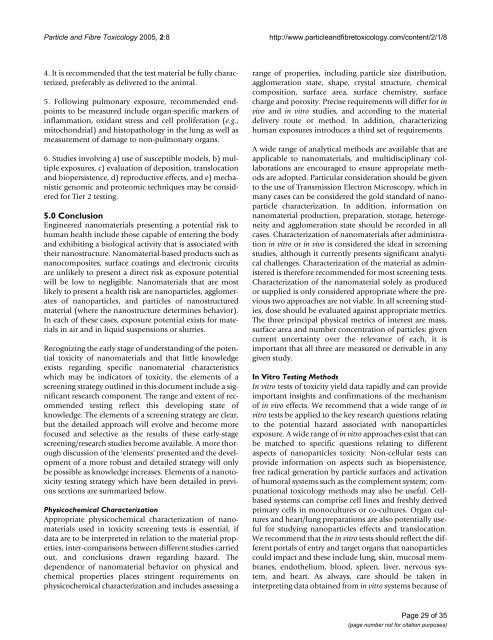Particle and Fibre Toxicology - Nanowerk
Particle and Fibre Toxicology - Nanowerk
Particle and Fibre Toxicology - Nanowerk
You also want an ePaper? Increase the reach of your titles
YUMPU automatically turns print PDFs into web optimized ePapers that Google loves.
<strong>Particle</strong> <strong>and</strong> <strong>Fibre</strong> <strong>Toxicology</strong> 2005, 2:8<br />
http://www.particle<strong>and</strong>fibretoxicology.com/content/2/1/8<br />
4. It is recommended that the test material be fully characterized,<br />
preferably as delivered to the animal.<br />
5. Following pulmonary exposure, recommended endpoints<br />
to be measured include organ-specific markers of<br />
inflammation, oxidant stress <strong>and</strong> cell proliferation (e.g.,<br />
mitochondrial) <strong>and</strong> histopathology in the lung as well as<br />
measurement of damage to non-pulmonary organs.<br />
6. Studies involving a) use of susceptible models, b) multiple<br />
exposures, c) evaluation of deposition, translocation<br />
<strong>and</strong> biopersistence, d) reproductive effects, <strong>and</strong> e) mechanistic<br />
genomic <strong>and</strong> proteomic techniques may be considered<br />
for Tier 2 testing.<br />
5.0 Conclusion<br />
Engineered nanomaterials presenting a potential risk to<br />
human health include those capable of entering the body<br />
<strong>and</strong> exhibiting a biological activity that is associated with<br />
their nanostructure. Nanomaterial-based products such as<br />
nanocomposites, surface coatings <strong>and</strong> electronic circuits<br />
are unlikely to present a direct risk as exposure potential<br />
will be low to negligible. Nanomaterials that are most<br />
likely to present a health risk are nanoparticles, agglomerates<br />
of nanoparticles, <strong>and</strong> particles of nanostructured<br />
material (where the nanostructure determines behavior).<br />
In each of these cases, exposure potential exists for materials<br />
in air <strong>and</strong> in liquid suspensions or slurries.<br />
Recognizing the early stage of underst<strong>and</strong>ing of the potential<br />
toxicity of nanomaterials <strong>and</strong> that little knowledge<br />
exists regarding specific nanomaterial characteristics<br />
which may be indicators of toxicity, the elements of a<br />
screening strategy outlined in this document include a significant<br />
research component. The range <strong>and</strong> extent of recommended<br />
testing reflect this developing state of<br />
knowledge. The elements of a screening strategy are clear,<br />
but the detailed approach will evolve <strong>and</strong> become more<br />
focused <strong>and</strong> selective as the results of these early-stage<br />
screening/research studies become available. A more thorough<br />
discussion of the 'elements' presented <strong>and</strong> the development<br />
of a more robust <strong>and</strong> detailed strategy will only<br />
be possible as knowledge increases. Elements of a nanotoxicity<br />
testing strategy which have been detailed in previous<br />
sections are summarized below.<br />
Physicochemical Characterization<br />
Appropriate physicochemical characterization of nanomaterials<br />
used in toxicity screening tests is essential, if<br />
data are to be interpreted in relation to the material properties,<br />
inter-comparisons between different studies carried<br />
out, <strong>and</strong> conclusions drawn regarding hazard. The<br />
dependence of nanomaterial behavior on physical <strong>and</strong><br />
chemical properties places stringent requirements on<br />
physicochemical characterization <strong>and</strong> includes assessing a<br />
range of properties, including particle size distribution,<br />
agglomeration state, shape, crystal structure, chemical<br />
composition, surface area, surface chemistry, surface<br />
charge <strong>and</strong> porosity. Precise requirements will differ for in<br />
vivo <strong>and</strong> in vitro studies, <strong>and</strong> according to the material<br />
delivery route or method. In addition, characterizing<br />
human exposures introduces a third set of requirements.<br />
A wide range of analytical methods are available that are<br />
applicable to nanomaterials, <strong>and</strong> multidisciplinary collaborations<br />
are encouraged to ensure appropriate methods<br />
are adopted. Particular consideration should be given<br />
to the use of Transmission Electron Microscopy, which in<br />
many cases can be considered the gold st<strong>and</strong>ard of nanoparticle<br />
characterization. In addition, information on<br />
nanomaterial production, preparation, storage, heterogeneity<br />
<strong>and</strong> agglomeration state should be recorded in all<br />
cases. Characterization of nanomaterials after administration<br />
in vitro or in vivo is considered the ideal in screening<br />
studies, although it currently presents significant analytical<br />
challenges. Characterization of the material as administered<br />
is therefore recommended for most screening tests.<br />
Characterization of the nanomaterial solely as produced<br />
or supplied is only considered appropriate where the previous<br />
two approaches are not viable. In all screening studies,<br />
dose should be evaluated against appropriate metrics.<br />
The three principal physical metrics of interest are mass,<br />
surface area <strong>and</strong> number concentration of particles: given<br />
current uncertainty over the relevance of each, it is<br />
important that all three are measured or derivable in any<br />
given study.<br />
In Vitro Testing Methods<br />
In vitro tests of toxicity yield data rapidly <strong>and</strong> can provide<br />
important insights <strong>and</strong> confirmations of the mechanism<br />
of in vivo effects. We recommend that a wide range of in<br />
vitro tests be applied to the key research questions relating<br />
to the potential hazard associated with nanoparticles<br />
exposure. A wide range of in vitro approaches exist that can<br />
be matched to specific questions relating to different<br />
aspects of nanoparticles toxicity. Non-cellular tests can<br />
provide information on aspects such as biopersistence,<br />
free radical generation by particle surfaces <strong>and</strong> activation<br />
of humoral systems such as the complement system; computational<br />
toxicology methods may also be useful. Cellbased<br />
systems can comprise cell lines <strong>and</strong> freshly derived<br />
primary cells in monocultures or co-cultures. Organ cultures<br />
<strong>and</strong> heart/lung preparations are also potentially useful<br />
for studying nanoparticles effects <strong>and</strong> translocation.<br />
We recommend that the in vitro tests should reflect the different<br />
portals of entry <strong>and</strong> target organs that nanoparticles<br />
could impact <strong>and</strong> these include lung, skin, mucosal membranes,<br />
endothelium, blood, spleen, liver, nervous system,<br />
<strong>and</strong> heart. As always, care should be taken in<br />
interpreting data obtained from in vitro systems because of<br />
Page 29 of 35<br />
(page number not for citation purposes)
















